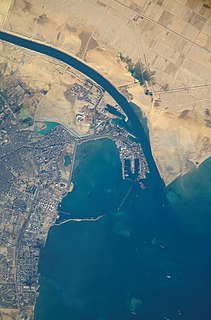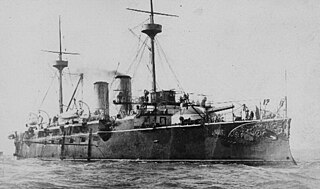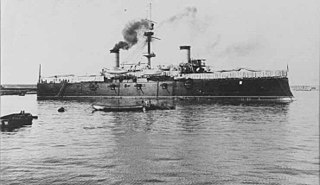 Buenos Aires with Camara's squadron at Port Said in 1898. The three funnels behind her belong to armored cruiser Emperador Carlos V | |
| History | |
|---|---|
| Name: | Buenos Aires |
| Namesake: | Buenos Aires, the capital of Argentina |
| Builder: | William Denny and Brothers |
| Completed: | 1887 |
| Acquired: | 1898 |
| Fate: | Returned to mercantile service 1898; scrapped 1942 |
| Notes: | In mercantile service 1887–1898 and 1898–1942 |
| General characteristics | |
| Type: | Transport |
| Propulsion: | steam |
Buenos Aires was a merchant ship requisitioned for use as a transport by the Spanish Navy in June and July 1898 during the Spanish–American War.

The Spanish Navy is the maritime branch of the Spanish Armed Forces and one of the oldest active naval forces in the world. The Spanish navy was responsible for a number of major historic achievements in navigation, the most famous being the discovery of America by Christopher Columbus and the first global circumnavigation by Magellan and Elcano. For several centuries, it played a crucial logistical role in the Spanish Empire and defended a vast trade network across the Atlantic Ocean between the Americas and Europe and across the Pacific Ocean between Asia and the Americas.

The Spanish–American War was fought between the United States and Spain in 1898. Hostilities began in the aftermath of the internal explosion of USS Maine in Havana harbor in Cuba, leading to U.S. intervention in the Cuban War of Independence. U.S. acquisition of Spain's Pacific possessions led to its involvement in the Philippine Revolution and ultimately in the Philippine–American War.
Contents
Buenos Aires was built in 1887 and was in commercial service until the Spanish Navy requisitioned her for Spanish–American War service in June 1898. [1] Serving as a transport, she became part of the relief expedition for the Philippines commanded by Rear Admiral Manuel de Camara and charged with destroying the United States Navy Asiatic Squadron of Commodore George Dewey there, as well as with delivering 4,000 Spanish Army troops to reinforce the Philippines. [2] Camara's squadron—consisting of battleship Pelayo, armored cruiser Emperador Carlos V, auxiliary cruisers Patriota and Rapido, destroyers Audaz, Osado, and Proserpina, and transports Panay, Alfonso XII, and Antonio Lopez, and four colliers as well as Buenos Aires—sortied from Cadiz on 16 June 1898. [3]

The Philippines, officially the Republic of the Philippines, is an archipelagic country in Southeast Asia. Situated in the western Pacific Ocean, it consists of about 7,641 islands that are categorized broadly under three main geographical divisions from north to south: Luzon, Visayas, and Mindanao. The capital city of the Philippines is Manila and the most populous city is Quezon City, both part of Metro Manila. Bounded by the South China Sea on the west, the Philippine Sea on the east and the Celebes Sea on the southwest, the Philippines shares maritime borders with Taiwan to the north, Vietnam to the west, Palau to the east, and Malaysia and Indonesia to the south.

The United States Navy (USN) is the naval warfare service branch of the United States Armed Forces and one of the seven uniformed services of the United States. It is the largest and most capable navy in the world, with the highest combined battle fleet tonnage and the world's largest aircraft carrier fleet, with eleven in service, and two new carriers under construction. With 319,421 personnel on active duty and 99,616 in the Ready Reserve, the Navy is the third largest of the service branches. It has 282 deployable combat vessels and more than 3,700 operational aircraft as of March 2018, making it the second largest and second most powerful air force in the world.

The Asiatic Squadron was a squadron of United States Navy warships stationed in East Asia during the latter half of the 19th century. It was created in 1868 when the East India Squadron was disbanded. Vessels of the squadron were primarily involved in matters relating to American commerce with China and Japan, though it participated in several conflicts over 34 years of service until becoming the Asiatic Fleet in 1902.
Buenos Aires and her consorts passed Gibraltar on 17 June 1898 [4] (first detaching Alfonso XII and Antonio Lopez to make independent voyages to the Caribbean), and arrived at Port Said, Egypt on 26 June 1898. [5] There Camara requested permission to transship coal, which the Egyptian government finally denied on 30 June 1898 out of concern for Egyptian neutrality. [6]

The Caribbean is a region of The Americas that consists of the Caribbean Sea, its islands and the surrounding coasts. The region is southeast of the Gulf of Mexico and the North American mainland, east of Central America, and north of South America.

Port Said is a city that lies in north east Egypt extending about 30 kilometres (19 mi) along the coast of the Mediterranean Sea, north of the Suez Canal, with an approximate population of 603,787 (2010). The city was established in 1859 during the building of the Suez Canal.

Egypt, officially the Arab Republic of Egypt, is a country spanning the northeast corner of Africa and southwest corner of Asia by a land bridge formed by the Sinai Peninsula. Egypt is a Mediterranean country bordered by the Gaza Strip and Israel to the northeast, the Gulf of Aqaba and the Red Sea to the east, Sudan to the south, and Libya to the west. Across the Gulf of Aqaba lies Jordan, across the Red Sea lies Saudi Arabia, and across the Mediterranean lie Greece, Turkey and Cyprus, although none share a land border with Egypt.
By the time Buenos Aires and the rest of Camara's squadron arrived at Suez on 5 July 1898, [7] the squadron of Vice Admiral Pascual Cervera y Topete had been annihilated in the Battle of Santiago de Cuba, freeing up the U.S. Navy's heavy forces from the blockade of Santiago de Cuba. Fearful for the security of the Spanish coast, the Spanish Ministry of Marine recalled Camara's squadron on 7 July 1898. [8] Buenos Aires and the rest of the squadron departed Suez on 11 July 1898 for Spain. [9]

Suez is a seaport city in north-eastern Egypt, located on the north coast of the Gulf of Suez, near the southern terminus of the Suez Canal, having the same boundaries as Suez governorate. It has three harbours, Adabya, Ain Sukhna and Port Tawfiq, and extensive port facilities. Together they form a metropolitan area. Railway lines and highways connect the city with Cairo, Port Said, and Ismailia. Suez has a petrochemical plant, and its oil refineries have pipelines carrying the finished product to Cairo, in the flag of the governorate: the blue background refer to the sea, the gear refer to the fact that Suez an industrial governorate, and the flame refer to the petroleum firms in it.

Admiral Pascual Cervera y Topete was a prominent Spanish naval officer with the rank of Almirante (admiral) who served in a number of high positions within the Spanish Navy and had fought in several wars during the 19th century. Having served in Morocco, the Philippines, and Cuba, he went on to be Spain's naval minister, chief of naval staff, naval attaché in London, the captain of several warships, and most notably, commander of the Cuba Squadron during the Spanish–American War. Although he believed that the Spanish Navy was suffering from multiple problems and that there was no chance for victory over the United States Navy, Cervera took command of the squadron and fought in a last stand during the Battle of Santiago de Cuba.

The Battle of Santiago de Cuba was a naval battle that occurred on July 3, 1898, in which the United States Navy decisively defeated Spanish forces, sealing American victory in the Spanish–American War and achieving nominal independence for Cuba from Spanish rule.
By the end of July 1898, Buenos Aires had returned to commercial service. After a long life, she was scrapped in 1942. [10]

















